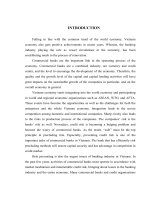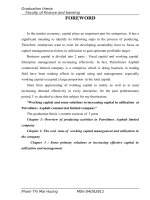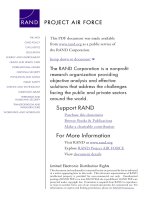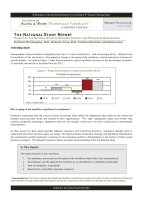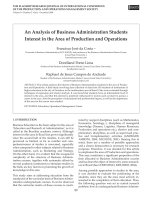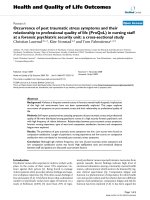Analysis of strategic definition and enterprise’s administration in Viet–Lao company and recommend solutions to raise quality of business strategy definition
Bạn đang xem bản rút gọn của tài liệu. Xem và tải ngay bản đầy đủ của tài liệu tại đây (717.46 KB, 66 trang )
CAPSTONE PROJECT REPORT
Group 8 - Class GaMBA01.V02
GRIGGS UNIVERSITY
GLOBAL ADVANCED MASTER OF BUSINESS ADMINISTRATION PROGRAM
CAPSTONE PROJECT REPORT
Analysis of strategic definition and enterprise’s
administration in Viet–Lao company and recommend solutions
to raise quality of business strategy definition
Class : GaMBA01.V02
Group : 8
Members :
1. Mr. Lê Phúc Ân
2. Mr. Nguyễn Anh Thắng
3. Mr. Phạm Văn Thạch
4. Mr. Võ Hồng Sơn
Vinh, 10/2010
CAPSTONE PROJECT REPORT
Group 8 - Class GaMBA01.V02
TABLE OF CONTENT
Page
List of abbreviations
1
List of tables
1
Preface
3
Chapter I: theory basis of business strategy and business strategy
defining of enterprise
6
I / Definition, role and level of business strategy
6
1. Definition of business strategy and strategic administration
6
2. The role of business strategy for enterprise’s development
6
3. Strategy levels
7
II / Construct business strategy of enterprise
7
1. Requirements and basis in constructing business strategy
7
2. Viewpoints of business strategy construction
8
3. The process to construct business strategy
8
4. Introduction of strategic analysis models
11
Chapter II: Assess reality of defining strategy and enterprise
administration in Viet–Lao Ltd. Company
15
I. General view of Viet–Lao Ltd. Company
15
1. Formation and development of Viet–Lao Ltd. Company
15
2. Basic factors impact on strategic construction in Viet–Lao Ltd. Company
16
II. Analysis of strategic task and enterprise’s administration in Viet–
Lao Ltd. Company
21
1. Analysis of business environment
21
CAPSTONE PROJECT REPORT
Group 8 - Class GaMBA01.V02
2. Target definition
33
3. Solutions to implement targets
35
III. Reality of strategic administration machine
36
IV. Reality of experts of strategic construction
37
V. Achieved results and limitations in defining strategy and
enterprise’s administration in Viet–Lao Ltd. Company
37
1. Achieved results
37
2. Limitations
38
3. Reason of limitations
39
Chapter III: some recommendations to raise quality of business
strategy in Viet–Lao Ltd. Company
41
I. Orientation for business strategy construction in Viet–Lao Ltd.
Company
41
II. Some recommendations to raise quality of business defining in Viet–
Lao Ltd. Company
43
1. Improve the process to build up business strategy
43
2. Improve strategic management machine
58
3. Raise quality of cadres of planning.
58
III. Limitations of the process and future study
59
Conclusion
61
List of references
62
Some images of Viet–Lao Ltd. company
63
1
CAPSTONE PROJECT REPORT
Group 8 - Class GaMBA01.V02
LIST OF ABBREVIATIONS
No.
ABBREVIATIONS
SIGNIFICANCES
1
AFTA
Asian Free Trade Association
2
B2B
Business to businesses
3
B2C
Business to customers
4
CO
Company
5
ETC
Centre for educational technology and career system
6
LTD
Limited liability
7
USD
United state of America dollar
8
WTO
World Trade Organization
9
VILACO
Viet-Lao limited company
10
VND
Viet Nam dong
LIST OF TABLES
No.
TABLE No.
NAME OF TABLE
Page
1
Table 2.1
Organizational diagram of Viet–Lao Ltd.
Company
18
2
Table 2.2
Current human resource of Viet–Lao Ltd.
Company
19
3
Table 2.3
Machine for exploiting, processing raw plaster
19
4
Table 2.4
Financial data of Viet–Lao Ltd. Company
20
5
Table 2.5
Opportunities and threatens of the company
within 2010 – 2015
27
6
Table 2.6
Financial norms of Viet–Lao Ltd. Company
29
2
CAPSTONE PROJECT REPORT
Group 8 - Class GaMBA01.V02
7
Table 2.7
Competitive profile matrix
32
8
Table 2.8
Strengths and weaknesses of Viet–Lao Ltd.
Company
33
9
Table 2.9
Economic norms within 2007 – 6/2010 of Viet-
lao Ltd. company
38
10
Table 3.1
Process to construct business strategy
43
11
Table 3.2
Synthesis of external factors evaluation (EFE)
45
12
Table 3.3
Internal factor evaluation (IFE)
46
13
Table 3.4
BCG matrix of Viet–Lao Ltd. Company
47
14
Table 3.5
MC Kinsey matrix of Viet–Lao Ltd. Company
49
15
Table 3.6
Attraction of business sector
50
16
Table 3.7
Competitiveness of the company
50
17
Table 3.8
SWOT matrix of Viet–Lao Ltd. Company
51
18
Table 3.9
Marking strategic alternative
54
19
Table 3.10
Some annual targets of Viet–Lao Ltd. Company
within 2010 – 2015
57
3
CAPSTONE PROJECT REPORT
Group 8 - Class GaMBA01.V02
PREFACE
1. Reason for topic choice
Since 1986, the Party and the State have got big policy to transfer subsidized -
economy into market economy according to socialism orientation, reduce
protectionism policy and give many preferential treatments for individuals and
organizations doing business and developing self-control economy.
Apart from innovation of domestic economic policy together with worldwide fast
development of informatics technology and globalization…,Vietnamese economy
has many positive changes. However, Vietnamese economy in general and
Vietnamese enterprises in particular just make use of advantage from 3 factors
which are favorable business ground, material and cheap labor price; apply
incomprehensively administration and management science in business
administration.
Vietnamese economy has deeply integrated into global economy via unilateral,
multilateral treaties, commercial organizations such as AFTA, WTO, therefore,
Vietnamese enterprises must not only compete with each other within domestic and
foreign markets but also bear violent competition from worldwide enterprises with
long term experiences of finance, personnel administration as well as defining long
term development strategy. To exist and develop in such environment, enterprises
must apply administration and management sciences into business production which
is also an urgent requirement of Vietnamese enterprises.
Via learning and studying global executive master of business administration
program organized by Griggs University of the US and ETC of Ha Noi National
University; via collecting information and data of business activities of Viet–Lao
Co. Ltd., combining with knowledge of administration and management science
that the program has provided, our group has realized that activities of the company
recently have been rather good, however defining right long and medium term
orientation with prediction of business environment… is the necessary thing to do
4
CAPSTONE PROJECT REPORT
Group 8 - Class GaMBA01.V02
in current time. With achieved knowledge via the program, via realistic analysis of
business production of Viet–Lao Co. Ltd., our Group has studied and chosen the
topic “analysis of strategic definition and enterprise’s administration in Viet–Lao
company and recommend solutions to raise quality of business strategy
definition” to prepare capstone project report of Group 8.
2. Study purposes
Applying common theory basis on defining strategy and business strategy we can
analyze and assess reality of strategic definition and enterprise’s administration in
Viet–Lao Co Ltd., within the period of 2007 until 6/2010. Based on common theory
of strategic definition, enterprise’s administration and appliance of such theories
into Viet–Lao Co Ltd., Group 8 will go to study and suggest scientific solutions to
apply into the company in defining business strategy within the period of 2010 –
2015; at the same time, we can also draw experienced lessons for ourselves.
3. Study method
3.1 Data collection
Collect primary data: directly work in the company; interview leader, main cadres;
implement market survey such as investigation slip, realistic visiting of customers,
and competitive opponents of the company
Collect secondary data: from reports, materials of the company, professional
agencies; statistical directory, information on papers, TV, internet, books and
related materials…
3.2 Comparison and synthesis
Compare a norm with the basis (planning norm, previous year, sector, ) for
business data, common parameters of the market, average norms, other compared
norms; comparison condition is that data must be suitable to space, time, economic
content, measurable units, estimation method, scale and business condition .
3.3 Statistical method by tables
We can use synthesis data via statistical tables to find out trend or common feature
5
CAPSTONE PROJECT REPORT
Group 8 - Class GaMBA01.V02
of directly analyzed factors.
3.4 Appliance of models: PESTLE, SWOT, BCG, Five forces Porter, IFE,
4. Study scope
Analyze the task of strategic definition and enterprise administration in Viet–Lao
company last time and give some recommendations to raise quality of business
strategy definition within 2010 – 2015.
Capstone Project report of Group 8 has three chapters:
Chapter I: Theory basis of business strategy and business strategy defining of
enterprise
Chapter II: Assess reality of business strategy defining in Viet–Lao Co., Ltd.,
Chapter III: Some recommendations to raise quality of business strategy defining
in Viet–Lao Co Ltd.,.
6
CAPSTONE PROJECT REPORT
Group 8 - Class GaMBA01.V02
Chapter I: Theory basis of business strategy and business strategy defining of
enterprise
I. Business strategy and strategic levels
1. Definitions
There are many different definitions of business strategy and strategic
administration, but the current popular definition is that: “business strategy is the
total long term targets, big policies and solutions of business and production,
finance and human factor to make enterprise’s business develop to a higher quality
status”.
"Business strategy is a kind of commitment and action that a company uses to get a
competitive advantage by exploiting essential capacity within a defined market ".
"Strategic administration is the process to study present and future environments as
well as define organizational targets, find out, implement and check the
implementation of decisions to reach such targets in present and future
environment; strategic administration is supposed to be an art as well as a
science".
2. The role of business strategy for enterprise’s development .
Firstly, the main function of business strategy is to create a consistent orientation
for long and short term plans in the enterprise; in other words, business strategy can
help enterprise to realize clearly purposes and orientations for all business activities.
Secondly, together with the fast change and development of business environment,
opportunities and threatens will appear within the market; then business strategy can
help enterprise to grasp and make use of business opportunities, find out adjusted
solutions to overcome threatens.
Thirdly, business strategy can raise effect of using resources of enterprise, increase
competitive position, and ensure constant and sustainable development of the
enterprise in long term.
7
CAPSTONE PROJECT REPORT
Group 8 - Class GaMBA01.V02
Fourthly, construction of business strategy must create firm basis for enterprise to
find out suitable policy and decision with market’s changes.
3. Strategy levels
In each market with each kind of product, customers have relative independence;
each enterprise often has different strategies for different operational levels; as usual
there are three strategy levels:
3.1 Strategy in enterprise level
This strategy will define operational sector of enterprise, position of enterprise in
business environment and the role of each business sector in enterprise.
3.2 Strategy in unit level
It will define position of business sector in the enterprise, position of sector in
environment and define how to compete effectively in each sector.
3.3 Strategy in functional level
It is the strategy to support implementation of strategy in unit level and in enterprise
level, including the following strategies: research and development, production,
marketing, personnel, finance
Each enterprise should have three distinctive strategy levels; however
implementation of strategy must be comprehensive in three levels; at the same time,
due to strategic orientation then strategy in higher level will play more important
role.
II. Construct business strategy of enterprise
1. Requirements and basis to construct business strategy .
1.1 Requirements
When constructing (defining) business strategy, we must care for the following
requirements:
- Increase advantage of enterprise and occupy competitive advantage within the
market.
8
CAPSTONE PROJECT REPORT
Group 8 - Class GaMBA01.V02
- Enterprise must define target market; then define safe area in business and
business scope and risky level.
- Define clearly core targets and basic conditions to implement such targets.
- Grasp information and build up information system of market, customers,
providers and competitive opponents.
- Define standby strategies to use in urgent cases to avoid passiveness to confuse
system when strategic implementing gets stuck.
- Grasp opportunities with determination.
1.2 Basis
Important basis for constructing business strategies including:
- Customers: understand who is customer, what customer wants?
- Competitive opponents: strengths, weaknesses of opponents ,…
- Enterprise: strengths, weaknesses, competitive advantage of enterprise .
Economic experts suppose that enterprise must base on these three strategies to
construct business strategy for itself.
2. Viewpoint of business strategy construction
- Business strategy construction must be based on exploiting essential factors of
enterprise to get success ;
- Construct business strategy based on promoting advantages and comparing
advantages;
- Business strategy is constructed based on exploiting new factors and creative
factors ;
- Construct business strategy to exploit surrounding factors and essential factors.
3. Process for business strategy construction
3.1 Define vision, mission and strategic targets
9
CAPSTONE PROJECT REPORT
Group 8 - Class GaMBA01.V02
Leader of enterprise must define vision, mission and strategic targets of enterprise
in long term then implement activities to analyze business environment, give
strategic options and choose strategies to reach long term targets.
3.2 Study and predict external environment of enterprise
Analysis of external environment can realize opportunities and threatens for
business activities of enterprise .
3.2.1 Macro environment (5 factors)
- Economic factors:
Economic growth rate can arise new demand for economic development; inflate rate
can impact on interest, investment interest rate; unemployment rate, recruitment and
dismissal; exchange rate impact on banking interest, financial policy, price and
payment scale.
- Political factor (this group of factor can play important role):
Stability of authority; regulations of tax, fees, charges; regulation of recruitment and
dismissal of workers; regulation of environmental safety and protection
- Social factors
Living standard; customs and traditions; regional culture; population increase rate
- Natural factors:
Natural ressources, environnemental pollution, energy insufficiency
- Technological factor:
Fast development of current technology can create opportunities as well as potential
threatens for existence and development of enterprise; enterprise must have plan to
apply science and technology in flexible way to avoid being passive and outdated.
3.2.2 Micro environment (operational environment)
Operational environment including factors of sector and external factors for
enterprise, deciding levels and competitive quality within such sector; there are 5
basic factors (5 market forces): customers; providers; replaced products; current
competitive opponents and potential competitive opponents; enterprise must
10
CAPSTONE PROJECT REPORT
Group 8 - Class GaMBA01.V02
analyze such factors to realize opportunities and threatens that enterprise must cope
with.
3.3 Study and predict internal factors of enterprise
This is to analyze reality and internal force of enterprise’s resources to realize
strengths and weaknesses then to have methods to promote strengths, adjust
weaknesses; the analysis focuses on the following problems:
3.3.1 Analyze enterprise’s resources
- Human resource: leader machine; qualification, morality and quality of cadres and
employees; adaptable capacity in case of changes ;
- Financial sources: focus on the problems such as capital allocation, effect of using
capital, financial norms ;
- Technological resource: factory; store, port, road, transportation media,
equipments and machines ;
- Marketing analysis: this is an important content in internal analysis which allows
assessing capacity to meet market’s demand of enterprise, focusing on the following
problems: product type, product quality, market share, price, customers’ trust…
3.3.2 Analysis of organizational capacity of enterprise
Assessment of organizational task of enterprise is to answer two questions: is
enterprise’s organization suitable to requirements of business strategy? Can it have
enough force to implement given strategies? The content of this analysis is:
- Reality of organizational structure of enterprise including: organizational system
and operational regulation;
- Adaptable capacity of organization with market’s changes and business condition.
3.3.3 Analysis of competitiveness of enterprise
Competitiveness of enterprise is the capacity of enterprise to maintain and improve
its own within the market sustainable.
Factors impact on competitiveness of enterprise:
- Profitability of invested capital;
11
CAPSTONE PROJECT REPORT
Group 8 - Class GaMBA01.V02
- Labor productivity;
- Product price and capacity to lower product price of enterprise;
- Business experiences within the market;
- Flexibility, sensitivity of leaders in enterprise;
- Quality of product and service
- Working environment within the enterprise.
3.4 Construct strategic options
Enterprise can have many ways to analyze and find out strategic options based on
realistic business condition; however, the usage of scientific method such as
appliance of matrix, models…to analyze will find out close and logical strategic
options.
3.5 Analysis and choice of strategic options
Based on strategic options, we can study and select strategic options; we can choose
the better options within constructed options then choose the best option.
After analyzing and choosing strategies, leading board will assess strategies for
owners to make strategic decisions to concretize chosen strategies to be the basis for
implementing the next steps of strategy.
Strategic decision is the intelligence products of leader which must be based on the
following grounds:
- Decision to follow common targets, long term targets of the system;
- Decision of the system must follow the law and social rules;
- Decision must be based on available resources of the system or ensure
mobilization;
- Timely decision-making.
3.6 Strategy implementation
This is the important phase to turn defined strategies into concrete actions.
Strategy implementation can deeply impact on the whole enterprise then impact on
divisions and functional offices; with regard to implementing strategy, individual
12
CAPSTONE PROJECT REPORT
Group 8 - Class GaMBA01.V02
skills are very important; implementing strategies can include strategic development
such as supporting budget, cultural programs of the company, connect with system
of encouraging and complimenting cadres and employees
Strategy implementation can succeed or fail which depends not only on strategic
quality but also depends on capacity to promote cadres and employees of
administrators.
3.7 Assess and check strategic implementation
In the process of strategic implementation, we must organize to consider such
strategies to be done as expected? There are many reasons which make a certain
strategy not reach given targets. Such reasons are due to the changes of
environmental background or not attract human resource. Then we must grasp
system of feedback information and methods to check and monitor implementation.
4. Models for strategic analysis
4.1 Models to analyze internal and external environment of the enterprise
4.1.1 PEST analysis
- P: Politics;
- E: Economy;
- S: Social culture;
- T: Technology
4.1.2 The five-force model of the market
- Potential opponents ( threatens of new competitive opponents );
- Competitors within the sector;
- Supplier;
- Customers;
- Replaced products.
4.1.3 SWOT analysis
- S: strengths
- W: weaknesses
13
CAPSTONE PROJECT REPORT
Group 8 - Class GaMBA01.V02
- O: opportunities;
- T: threatens.
4.2 Model to define operational list of the enterprise
BCG Matrix diagram of increased market share: this is rather classical and simple
matrix, which is suitable to define position of enterprise, relation between market
share of enterprise and product growth rate;
MC Kensey matrix, I E F: set up table of assessment (or marking) for external and
internal factors of the enterprise and compare with competitive opponents, sector’s
mean…; define attraction level of business sector, competitiveness of enterprise to
define list.
4.3 Model of general strategy
4.3.1 Model of growth strategy
Target of growth strategy is to increase business scale, revenue, market share then
increase profit in business and production; growth strategy can be done according to
the following methods:
- Direct expansion;
- Diversification of business activities;
- Expansion.
4.3.2 Stable strategy
Target of stable strategy is to ensure stability and existence as well as keep position
of enterprise within the market by:
- Centered and cautious investment;
- Maintain existing product list and go to deep specialization, raise prestige and
expand scale.
4.3.3 Strategy to narrow down or withdraw
Target of this strategy is to maintain force and focus strengths into main products to
stand tall within the market.
14
CAPSTONE PROJECT REPORT
Group 8 - Class GaMBA01.V02
To do this, enterprise must find out strategic methods such as: reduce activities or
reduce product list then reduce investment scale to maintain existing stability.
Besides, enterprise can implement the following strategy: studying to transfer
business orientation, find out replaced products and markets.
Solution in force majored is to go into liquidation or bankruptcy.
4.3.4 Mixed strategy
Each organization and each enterprise often operates with many targets; then in
each period it can implement some certain targets with relative independence then
we must combine above strategies to promote advantages and limit risks.
4.4 Model of competitive strategy
Model of competitive strategy of Porter is defined by two basic factors which are
competitive scope and competitive advantage of products; using the matrix of
competitive images we can compare between company with main competitive
opponents within the sector which is based on influences on competitive capacity of
the company within the sector. Then administrators will realize strengths and
weaknesses of the company compared to competitive opponents, define competitive
advantage for company and adjusted limitations: Cost-oriented strategy, differential
strategy and centre strategy.
4.5 Model of functional strategy
After defining general strategy, enterprise will define functional strategies to
implement general strategies including: Financial strategy; Personnel strategy;
Marketing strategy; Technological strategy; Production strategy; Investment
strategy;…
Common theory basis mentioned in this chapter will be the basis for analysis and
evaluation of strategy construction reality of the company in chapter 2 and chapter 3
of the capstone project report.
15
CAPSTONE PROJECT REPORT
Group 8 - Class GaMBA01.V02
Chapter II: Evaluation of reality of business strategy defining in Viet-Lao
Company
I. Formation, development and basic factors impact on business strategy
construction in Viet–Lao Company
1. Formation, development of Viet–Lao Co., Ltd.,
In 2004 company was established under the joint venture form with full name of
Viet–Lao joint venture company; in Viet Nam (Ha Tinh Minerals and Trading
Corporation) occupies 85% stocks and Laos occupies 15%; Company signs contract
to exploit and construct factory of processing plaster with Laos Government;
company is issued plaster mine with reserves of more than 22 million tons with
exploited ground area of 700 ha; contract validity of 30 years with twice extension
for each ten years;
In 2005 the company officially went to exploit; the first exploiting quantity reaches
50,000 tons raw ore/year. Company has implemented activities to penetrate into
consumption market in Laos and Viet Nam but still got many difficulties;
In 2006 the products are accepted by customers in Laos and Viet Nam; production
quantity reaches 100,000 tons/year– sale quantity of 50,000 tons/year; company
also opens representative office in Viet Nam;
In 2007 Laos suggested and Vietnamese investors accepted to buy stocks that Laos
holds then company is transferred into Viet–Lao Ltd. Company with 100% foreign-
invested capital whose investor is Ha Tinh Minerals and Trading Corporation;
In 2007 the company invested in plaster grinding factory with invested capital of 1
million USD until 6/2008 the factory officially went to production and launched
products to the market;
In 2009 quantity of exploited raw plaster reached 250,000 tons/year, consumption
quantity reached 220,000 tons/year, mainly consumption in Viet Nam;
At the beginning of the year 2010, it has invested in production line of handicraft
plaster in Laos.
16
CAPSTONE PROJECT REPORT
Group 8 - Class GaMBA01.V02
Information of Viet–Lao company:
Name : Viet–Lao limited company
Abbreviated name : VILACO
Address: Tung, Bunghoana, Xephangxay district, Khammuone province, Laos
Representative office in Viet Nam : No. 2 Vũ Quang, Ha Tinh city, Ha Tinh Pro.,
Tel/Fax : (00856)51.210.129
Website :www.thachcaovn.com.vn
2. Basic factors impact on business strategy construction in Viet–Lao Co., Ltd.,
2.1 Influence from business strategy of investor in Viet Nam – Ha Tinh Minerals
and trading Corporation
2.1.1 The role of company in corporation’s development
Ha Tinh Minerals and Trading Corporation is a State-owned enterprise established
according to Decision of Vietnamese Prime Minister which is directly under
management of Ha Tinh Provincial people’s Committee; the corporation operates
with many sectors including exploiting, processing and trading minerals with 28
member units;
Viet Nam – Laos Ltd. Company is defined as one of important unit to develop
corporation in long term; corporation can create all conditions in term of policies,
human resource, and financial resource to support company in all activities;
Company has independent accounting with corporation which is suitable to
regulations of Laos and Resolution promulgated by Corporation.
2.1.2 Influence from business strategy of corporation
This is the unique unit of the corporation operating abroad then corporation will let
the company to construct private development strategy which is suitable to the
distinction of the unit and the Law of Laos and Viet Nam as well as regulations of
international business;
Business strategy in long and medium term is established by the company and
agreed and approved by company.
17
CAPSTONE PROJECT REPORT
Group 8 - Class GaMBA01.V02
2.2 Products feature of the company
Currently, company provides products and services including: raw gypsum, plaster
powder, gypsum ceiling and transportation; each product with technical quality and
consumption market can impact on business strategy defining of the enterprise, as
follows:
2.2.1 Raw gypsum (gypsum rock)
Raw gypsum is exploited from natural mines which are mainly used for cement
production; this is also the main products to create main income for the company in
recent time and within five coming years. Currently, products are consumed by
cement factories in Laos and Viet Nam; the products can prove its own quality and
occupies 40% market share in Laos and 25% in Vietnamese market.
2.2.2 Plaster powder
Products are used to be the patterns in producing porcelain and pottery, produce
plaster partition, ceiling…the product is consumed in Laos and Viet Nam markets;
company is focusing on raising product quality to meet customers’ demand.
2.2.3 Gypsum ceiling
This is the new product of the company including gypsum ceiling and partition;
currently the company is trying to produce handicraft plaster from Thailand
technology and testing in the markets of Laos and Viet Nam.
2.2.4 Transportation business
Company has trucks to transport commodities; however due to small quantity of
trucks then it just focuses on transporting plaster of company to consume in Laos
and Viet Nam.
2.3 Features of organizational structure
Organizational structure of the company includes: member council, monitoring
board, director board and divisions, offices.
18
CAPSTONE PROJECT REPORT
Group 8 - Class GaMBA01.V02
Member council includes 3 members, Chairman of member council is General
Director of the Corporation (investor); Director of the company is one of three
members;
Monitoring board: including 3 members, head of monitoring board is a managing
cadre of the corporation (investor);
Director board: including one managing director and one deputy business director;
Functional offices: accounting office; business office; office of administration and
organization; exploiting team; transportation team; mechanic team; managing
division of production factory and representative office in Viet nam.
Table 2.1: Organizational diagram of Viet–Lao Ltd. Company
2.4 Features of labors and salary
Total cadres of company include 105 people including 55 Vietnamese labors and
50 Laos labors;
Member
council
Director
Business deputy
director
Monitoring
board
busines
s office
acco
untin
g
offic
e
admi
nistra
tive –
labor
offic
e
mech
anic
grou
p
exploiti
ng
group
transpor
tation
group
powd
er
facto
ry
Repr
esent
ative
offic
e in
Viet
Nam
19
CAPSTONE PROJECT REPORT
Group 8 - Class GaMBA01.V02
Table 2.2: Current human resource of Viet–Lao Ltd. Company
No.
Qualification
Quantity
Rate (%)
1
University
11
10,48
2
College – intermediate school
6
5,71
3
Technical workers
50
47,61
4
Popular labors
38
36,20
(Source: provided by Viet–Lao Ltd. Company)
Salary and current allowances:
Average salary of labors (million dong/person/month) has increased recently (in
2006: 1,7 million dong; in 2007:3,0 million dong; in 2008: 3,8 million dong; in
2009: 4,5 million dong); company also gives many allowances such as eating,
traveling, social insurance…and implement policy of medical insurance, social
insurance,… as defined by Viet Nam and Laos law. Besides, company also has
many reward policies by money or other forms such as tourism, reward
accumulation at the end of the year ,…
2.5 Feature of machines, equipments and technological line
2.5.1 Machine for exploiting, processing raw plaster
Table 2.3: Machine for exploiting, processing raw plaster
No.
Machine and equipment
Quantity
1
Excavator
7
2
Bulldozer
1
3
Truck
6
4
Hammer of water pressure
1
5
Drilling
2
6
Air pressed machine
1
7
Steam shovel
1
8
Electronic weighing station of 80 tons
1
20
CAPSTONE PROJECT REPORT
Group 8 - Class GaMBA01.V02
9
Power station
1
10
Grinding station with capacity of 500,000 tons/year
1
(Source: prepared by Viet-Lao Ltd. Company)
2.5.2 Machine and equipments to grind plaster powder
Equipments and machines are comprehensively imported from China with
European technology, which automatically operate and meet production demand
and customers’ requirements; capacity to produce plaster powder is 30,000
tons/product/year (investment level in period I is 1 million USD).
2.5.3 Machine and equipments to produce plaster planks
Equipments and machines are comprehensively equipped from Vietnamese
producers, production technology is transferred from Thailand to produce high
quality products.
2.5.4 Truck for delivering commodities and market task
Currently, new group of truck has two tractors with tonnage of 80 tons which can
meet a small demand of commodity delivery of the company; company has two 4-
seat cars and one 7-seat car for market task.
2.6. Financial situation
Table 2.4: Financial data of Viet–Lao Ltd. Company (Unit: billion VND)
CONTENT
2007
2008
2009
Fixed asset
6,0
9,2
13,5
Mobile asset
4,4
25,7
48,9
Owner capital
21,1
29,6
39,8
Revenue
34,5
66,8
85,2
Profit
1,8
8,0
13,6
Post-tax profit
1,3
6,0
10,2
(Source: provided by Viet–Lao Ltd. Company)
II. Reality of business strategy construction in the company
21
CAPSTONE PROJECT REPORT
Group 8 - Class GaMBA01.V02
From the first year of operation (2004) the company has built up long term business
plan (from 2004 to 2010), however, to be suitable to new situation, in 2007
company has built up short term plan (1 year) and long term plan (3 years, 5 years).
Viet–Lao Ltd. Company has no official documents to define clearly development
strategy of the company and analyze the task of business strategy construction; long
term plan is considered as business strategy of the company.
The process of business strategy construction (long term plan) of the company is
divided into three following steps:
Step 1: Analyze business environment;
Step 2: Define targets;
Step 3: Find out solutions
1. Analysis of business environment
Company has legal status, main office then activities to exploit, produce in Laos
must follow law and regulations of Laos which bears impact of business
environment in Laos; However, company has Vietnamese investor under the
regulation of Vietnamese Law, besides products and services of company produced
in Laos are mainly consumed in Viet Nam which must bear impacts of business
environment in Viet Nam; then analysis of business environment can mention both
of Viet Nam and Laos, especially macro environment.
1.1 Analysis of business environment within 2007 - 2010
1.1.1 Macro environment
- Economic environment
Economy of Laos develops 5%/year on average in this current period, however,
economy of Laos is an outdated agricultural and service economy; consuming
products, tools, instruments, production materials must be imported; infrastructure
system for economic development in Laos has been invested by Laos Government
but not really comprehensive; current transportation system depends on road
transportation with high cost.
22
CAPSTONE PROJECT REPORT
Group 8 - Class GaMBA01.V02
Vietnamese economy in this period is strongly impacted from global economic
recession but can maintain rather high growth rate from 5-6%/year; infrastructure
system for economic development is invested rather comprehensively; budget over-
expenditure, inflate, foreign debt are controlled within safety limit which impact on
growth positively. Economic internal accumulation has reached above 15% GDP;
density of GDP of industry increases 20%;…
Economic relation between Viet Nam and Laos in recent time is very good; two
nations have created good conditions for enterprises to invest in business activities
within territories; Viet Nam is one of the biggest investors in Laos.
- Legal and political environment
Politics of Viet Nam and Laos are very stable in recent time; together with
improved legal system, it is the good condition for enterprises to do business
activities; two nations have many policies to attract foreign investment
comprehensively which is suitable to new situation.
- Social and cultural environment
Mental and spiritual life of people in Laos and Viet Nam are more and more raised;
educational system is strongly invested then people’s qualification is raised;
population is increased then people’s number in working age is high.
- Natural environment
Laos is the nation with many high value minerals; however in recent time both Viet
Nam and Laos have bad influences from floods, storm which badly impacts on
business activities.
- Technological and scientific environment
Science and technology of exploiting and processing is more and more developed,
however in recent time Viet Nam and Laos have not really followed and grasped
such development, especially in the field of production technology of mineral deep
processing.
1.1.2 Sector environment
